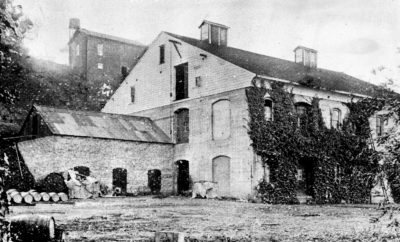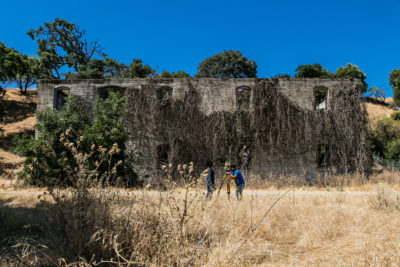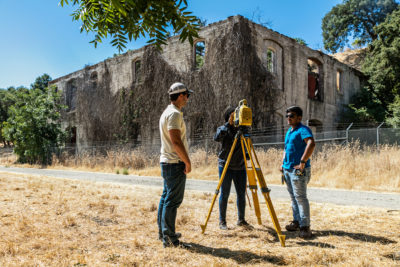
The latest technology, a Topcon GLS-2000 3D Laser Scanner, was used to capture the old Olivina Winery building’s structural dimensions.
Livermore, California has a famous light…or more precisely, a lightbulb. For more than a century now the 4-watt light bulb, called the Centennial Light, has been burning since it was first clicked on in 1901. Housed in the Livermore-Pleasanton Fire Department Station #6, it glows dimly, but still functions as a light bulb.
The Livermore community has other historical phenomena of note, including a historic building on the grounds of the Sycamore Grove Park. Predating Livermore’s historic lightbulb by about 15 years, the Olivina Winery building was constructed in 1885, which established one of the oldest wineries in the Livermore Valley. The Mediterranean-like climate–hot during the day and cool at night–is ideal for cultivating wine grapes and olive trees. Olivina pursued both businesses, thus the name, Olivina, coming from “olives” and “vines.”
The Olivina winery building was unique because it is the first gravity fed winery in California. The founders cleverly built the four-story structure up against a hill so that freshly-harvested grapes could be loaded into the fourth-floor mashing room from up on top of the hill. Each floor below contributed to the wine-making process filtering out stems and reducing the pulp to liquid. The ground floor is where the juice was processed and loaded into kegs for final fermentation.
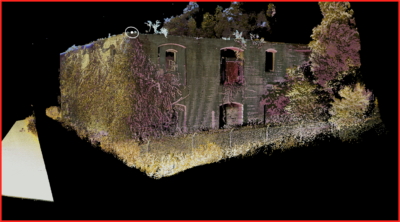
A scan originating from a GLS-2000 has a single distance accuracy of +/-3.5mm. When taking the whole surface into account, a model can be created with millimeter accuracy.
The hill not only provided the elevation for accessing the fourth floor, but was carved into to create an earth-cooled storage warehouse for the kegs filled with fermenting wine.
Olivina’s wine production remained strong until the combination of fatal vineyard diseases, which were first occurring in Livermore vineyards just before the 20th century and Prohibition ceased production for good in 1920.
The winery remained vacant, once production stopped.

The non-invasive approach taken with terrestrial scanning has allowed for a highly precise building exterior model to be captured.
“The building was fun to play in when we were kids,” said Charles T. Crohare, master miller at Olivina, LLC and fourthgeneration-son of one of the founders. “I remember climbing the redwood steps to the top floor and exploring the building which was also a `secret’ make-out place for high-school kids, as evidenced by spraypainted hearts with the likes of Johnny Loves Susie there for all to know.”
Through years of dormancy and neglect, the building has been deteriorating.
“In 1974 our family sold/donated 800 acres including the winery building to create the Sycamore Grove Park,” Crohare stated. “We were happy to see the land conserved and protected.”
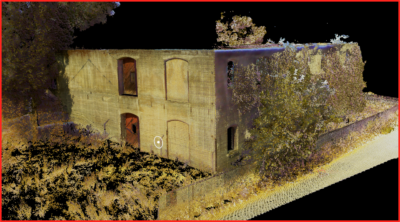
MAGNET Collage Web allows for annotation notes, retracing, and measuring distances and areas on the model directly from a web browser.
The Olivina land fits squarely into a South Livermore Development Plan that city, county, community leaders, and area businesses have all contributed to. The plan calls for preserving open space, controlling commercial and residential development, providing conservation easements, and ensuring that the land can be enjoyed by the community in perpetuity.
“It’s our understanding that the Olivina winery building is a future candidate for a historic restoration, museum, or community center,” stated Ron Oberlander who is with Topcon Positioning Systems, which is headquartered in Livermore. “That’s why we decided to donate our time, expertise, and resources to create thorough architectural documentation of the structure.”
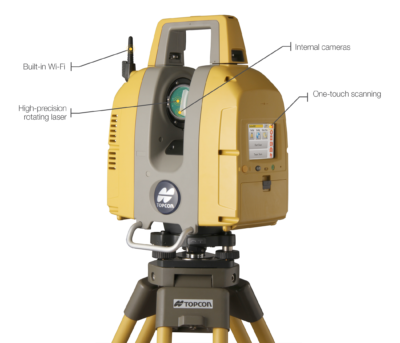
The compact high-speed Topcon GLS-2000 3D Laser Scanner provides a full dome 360°(H) and 270°(V) field-of-view (FOV), enabling the capture of point cloud data of the building.
The project became a learning opportunity for a group of Topcon interns who were able to use the most current Topcon technology and software to perform a 3D point-cloud scan for historical preservation purposes. With 3D scanning technology, the intern team captured precise dimensions in a noninvasive manner–in other words, no one needed to pass beyond the safety fencing or go into the building.
Weeks earlier the ruin next door collapsed. The intern team felt good that the scans they were completing will keep the dimensional data of the historic winery building protected from any such events. The data set can be used for later analysis such as taking measurements, tracing over a building layout, and converting the building into a computer model.
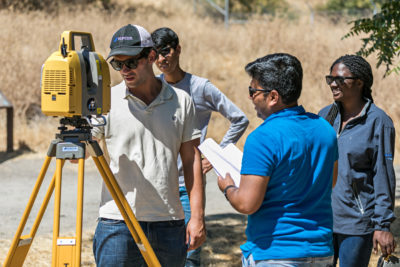
It didn’t take the crew of interns long to become comfortable with the Topcon GLS-2000 3D Laser Scanner.
The intern team used a Topcon GLS2000 3D Laser Scanner to capture the old Olivina Winery building’s structural dimensions. The eye-safe laser has a 1,640 foot (500 m) range which meant it could safely be positioned outside the deteriorating building’s cordoned-off safety parameter.
The Topcon device is said to provide survey-grade accuracy which reduces the number of scan settings and it features dual cameras designed to ensure the best definition.
Using newly launched MAGNET Collage Web software from Topcon, the intern team was able to take the 3D point clouds of the Olivina winery building it had recorded with the laser scanner and share them on the web. The integrated web service provides high-resolution point clouds of the winery building, which provides accurate distances, area measurements, and cross-sections that can be viewed, shared, or edited on the web.
“We’re quite pleased with the results of the Olivina Winery building project on so many levels,” said Oberlander. “Our interns had a meaningful project to further their learning, the Livermore Heritage Guild, which is a significant historical resource in the community, and the Crohare family now have definitive documentation of winery building, and the park service and community has valuable data for a time when any restoration might take place. A definite win for all involved!
